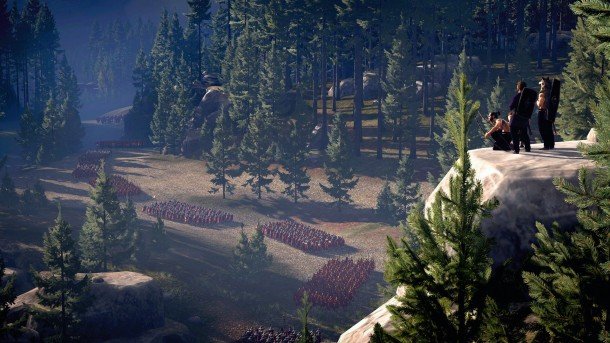Total War: Rome 2 preview - ambush and betrayal in the ancient world RTS

The Roman objective in Teutoburg, however, is simple: get out of the forest. Defeating the Germanic forces is a means to an end, in that regard, but sticking around to fight is suicidal. The barbarian army is supported by archers and war dogs, and as the Romans get bogged down in swampy ground they are beset on all sides. As I watch, the decisions being made are less about winning skirmishes and more about mitigating damage to the army's core: the three legionary eagle standards, revered symbols of Roman power whose loss, historically, was a source of national shame. On the hardest setting, the player will be required to extract all three eagles – in the version I'm seeing, however, simply not screwing up as badly as Varus did is all that's asked.
"The Roman objective in Teutoburg is simple: get out of the forest. Sticking around to fight is suicidal."
A cohort of infantry is left behind to cover the retreat as the Romans break the first wave of attackers. Later, another unit is sent into the forest to chase off a group of archers attacking the main group from a ridgeline – Bickham tells them to attack and then directs his attention elsewhere, spending the unit like currency to relieve the pressure on the rest of his forces. The road leading through the forest opens onto a wide, wet area of marshland, and for the first time it looks as if the Romans will have some space to breathe, to spread out and fight this like the open field battles they're good at. That's when the bulk of Arminius's army reveals itself: a horde of berserkers, breaking from the undergrowth and running fulltilt at the Romans.
For the first time in a Total War game, there's now height variance between individual men – even within a single unit of men. This fact becomes brutally relevant as a wall of half-naked, six-foot-tall barbarians crash into the Roman line. Another few cohorts are sacrificed as the rest of the army flees. Eventually, only two Roman units are left – far enough from the body of the Germanic army to escape, but blocked by a line of infantry. Bickham moves them into attack position then hammers the order to push through the German line, panic-clicking on an area just beyond the enemy troops. Also for the first time in a Total War game, this kind of urgent key-battering will actually work, troops interpreting repeated move orders as a sign that no, you really want them to disengage – albeit at the risk of increased casualties.
The mass of units is now calculated individually, so the likelihood of your units being able to escape will depend on type. In this case, the heavily armoured Romans are able to press the advantage and get away – a victory, of a sort. One of the escaping units was an eagle cohort, but its standard bearer fell in the field. All three eagles are gone. Still, Bickham has done better than Varus did.

With the camera set low over the Roman army there's a claustrophobic aspect to the battle I've not previously encountered in a Total War game. Part of this is the environment: Teutoburg's trees are five times bigger than Shogun 2's tallest, and it is possible to zoom the camera right down over the shoulder of an individual legionary and observe the way the low sun obscures vision as it casts long angular shadows over the forest floor. There's a sense that enemies could emerge from anywhere, and this is preserved even when the camera is zoomed all the way out to the new tactical view, where light is flattened, time slowed, and units are represented by translucent rectangles. This is thanks to a subtle but major change to the Total War formula: every unit now has dynamic, terrain-based line of sight, and no enemy unit is visible by default. No more steering your men towards a general magically marked out by a star on the battlefield.
"You get a much more claustrophobic effect when you're in a forest situation – and much less time to react."
“Each individual man is actually looking around him,” Ferguson explains. “He can see only what he can see. As a result of that you get a much more claustrophobic effect when you're in a forest situation – and much less time to react.”
The battle of the Teutoburg forest shows off this feature in its most obvious context: an ambush that relies specifically on surprise as a weapon. It has an impact on the entire game, however – even openfield battles.
Keep up to date with the most important stories and the best deals, as picked by the PC Gamer team.
“With the new system, a lot of existing maps have ambush opportunities in them,” lead unit designer Jack Lusted tells me. “It doesn't take a lot of re-engineering.” In Shogun 2, the average infantry unit moves at the speed of a marathon runner in order to reduce the time that armies spend closing the gap between one another – for Rome II, line of sight solves the same problem.
“The first thing that you discover is that a 30-meter hill – that's pretty good for hiding 15 units behind,” Ferguson says. Armies can surprise one another on the battlefield in ways that simply weren't possible under the old system.
Joining in 2011, Chris made his start with PC Gamer turning beautiful trees into magazines, first as a writer and later as deputy editor. Once PCG's reluctant MMO champion , his discovery of Dota 2 in 2012 led him to much darker, stranger places. In 2015, Chris became the editor of PC Gamer Pro, overseeing our online coverage of competitive gaming and esports. He left in 2017, and can be now found making games and recording the Crate & Crowbar podcast.


